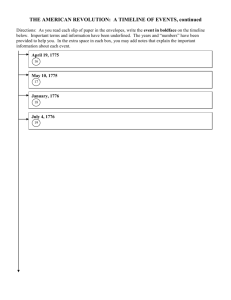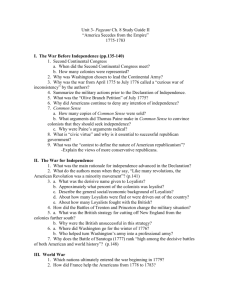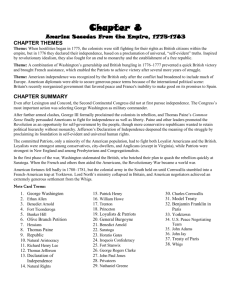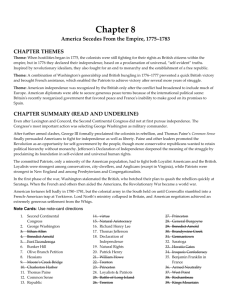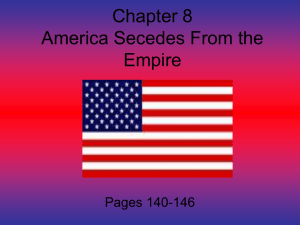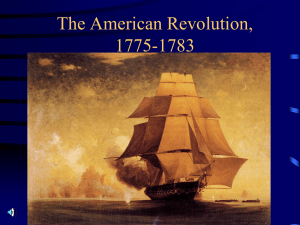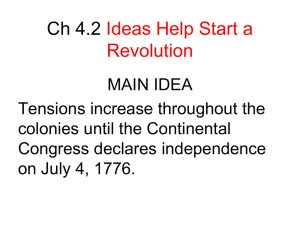America Secedes from the Empire 1775 - 1783
advertisement
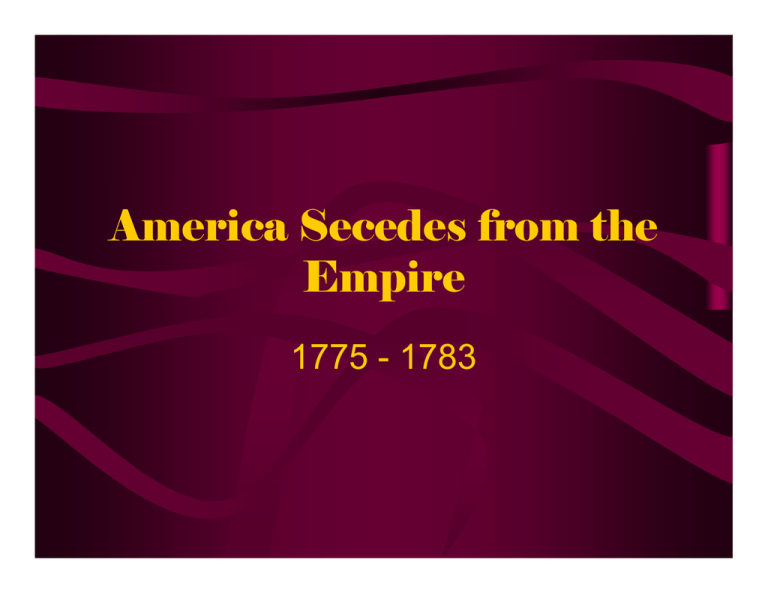
America Secedes from the Empire 1775 - 1783 April – May 1775 • May 10, 1775 – Second Continental Congress met in Philadelphia • No defined support for independence; Americans still hoped to get London to address their grievances The Two Continental Congresses Congress Drafts George Washington • George Washington chosen to lead the “army” moving to Boston – He was a well-known Virginia planter and member of Congress • Choosing Washington to lead was done in spite of many doubts – – – – Had combat experience, but 20 years before Never rose above rank of colonel in militia Largest command was only 1,200 men Not military genius; he lost more battles than he won General Washington Mount Vernon, George Washington's Estate in Virginia Congress Drafts George Washington • Washington’s strengths – Strong leader and strength of character – Moral force; symbol and rallying point for Americans – People trusted and were willing to follow him George Washington Congress Drafts George Washington • Congress’s reasons for choosing Washington – Largely political, not a military decision • Army assembling in Boston was mainly from New England; appointed Virginian to command to balance sections – Wealthy man, meaning he was not after money – Aristocratic, meaning he would not go too far in empowering the masses Washington Taking Command of the Army at Cambridge, 1775 Bunker Hill and Hessian Hirelings • From April 1775, after Lexington and Concord, to July 1776, when the Declaration of Independence was adopted, an inconsistent war between the British and Americans was fought – Americans claimed they were loyal to the king while raising armies and fighting British soldiers Bunker Hill and Hessian Hirelings • May 1775 – Ticonderoga and Crown Point – Americans under Ethan Allen and Benedict Arnold captured British forts with important gunpowder and artillery supplies Revolution the North, 1775–1776 Bunker Hill and Hessian Hirelings • June 1775 – Bunker (Breed’s) Hill – Colonists took Breed’s Hill overlooking Boston – British should have flanked (moved in from side or behind) the Americans – Instead, British charged up the hill with 3,000 men • Because the Americans were firmly entrenched, with 1,500 men, they mowed down the British until their gunpowder ran out and they were forced to retreat • The British lost 1,100 men; the Americans lost ony 300 Battle of Bunker Hill The Battle of Bunker Hill Bunker Hill and Hessian Hirelings • July 1775 – Olive Branch Petition – Olive branch is symbol of peace – Sent by Continental Congress to the king – Americans professed loyalty to crown and asked for an end of fighting – After Bunker Hill, the London government refused to consider peace The Olive Branch Petition Bunker Hill and Hessian Hirelings • In August 1775 the king officially rejected peace – He declared the colonies to be in rebellion – He made the colonists’ actions treasonable (punishable by death) Bunker Hill and Hessian Hirelings • September 1775 – king finalized deal to hire German mercenaries (known as Hessians) – Shocked the colonists because the king was bringing in foreign troops (known for butchery) into a “family” disagreement – Hessians were good soldiers, although many deserted to stay in America and get land Impressed Hessians Leaving Their Village for Dispatch to the American Colonies The Abortive Conquest of Canada • Fall 1775 – the colonists invaded Canada – Americans believed (wrongly) that the French wanted to kick the British out of Canada • The French had been treated well by the British (with the Quebec Act of 1774) and did not want to overthrow the British in Canada – Canada would become the 14th colony and deprive British of a launching point for invasions of America – Contradicted colonists’ claim they were fighting a defensive war to fix their problems with Britain The Abortive Conquest of Canada • The two-pronged invasion of Canada – Richard Montgomery went up Lake Champlain and the St. Lawrence River and captured Montreal – Benedict Arnold marched north through Maine – Montgomery and Arnold met at Quebec – In December 1775 their attack on Quebec was driven back • Arnold led the retreat along the St. Lawrence River after Montgomery was killed Revolution the North, 1775–1776 The Abortive Conquest of Canada • October 1775 – British burned Falmouth (Portland), Maine • January 1776 – British set fire to Norfolk, Virginia • March 1776 – British forced to evacuate Boston • 2 American victories in the South – February 1776 – Moore’s Creek Bridge in North Carolina, fighting Loyalists – June 1776 – Charleston harbor against invading British fleet Thomas Paine Preaches Common Sense • Moves toward independence came slowly – Loyalty to Britain was deeply ingrained – Colonial unity was poor – Open rebellion was dangerous • Irish rebels had been hanged, drawn and quartered Thomas Paine Preaches Common Sense • Events that moved America toward independence – Harsh British attacks like burning of Falmouth and Norfolk – Especially the hiring of the Hessians had angered Americans Thomas Paine Preaches Common Sense • January 1776 – Common Sense – Written by Thomas Paine, who had just come from England 1 year earlier – One of the most influential pamphlets ever written – Sold 120,000 copies in only few months Thomas Paine and Common Sense Thomas Paine Preaches Common Sense • Paine’s arguments in Common Sense – Called separation from Britain “common sense” – Nowhere in the heavens did a smaller body (like Britain) control a larger body (like America) – King was “the Royal Brute of Great Britain” Paine and the Idea of “Republicanism” • Paine’s radicalism – Called not only for independence but also creation of a new government – a republic • Paine’s republic – Power came from the people, not a king – All public officials (not just a house of commons) should be responsible to the people Paine and the Idea of “Republicanism” • Paine was not the first to argue for a republican government – Classical Greek and Roman political philosophers had invented the idea – Revived during the Renaissance in Europe and England (during the 1300s - 1600s) Greek Philosopher Plato Paine and the Idea of “Republicanism” • Republicanism and the British government – The idea in England coexisted uneasily with “mixed government” (one of a king, nobles, commoners) – Appealed to politicians wary of excessive power of the king and his ministers – Supported by colonists who saw king’s actions after 1763 as conspiracy to take away their liberties (based on the ideas of “radical Whigs”) Paine and the Idea of “Republicanism” • Colonial government prepared the colonists for republicanism – Colonists (especially in New England) had practiced a form of republicanism with town meetings and annual elections – Committees of correspondence demonstrated the workability of republicanism – America had no fixed hierarchy of power (no hereditary aristocracy; people were relatively equal because of the easy availability of land) Paine and the Idea of “Republicanism” • Republican virtue – Individuals in a republic had to sacrifice their personal self-interest for the public good – Collective good of all was more important than the rights and interests of individuals Paine and the Idea of “Republicanism” • Another interpretation of republicanism – Some Americans favored a republic ruled by a “natural aristocracy” of the talented – This would mean an end of hereditary aristocracy (based on birth), but not an end to social hierarchy (based on merit) – These people feared Paine’s radically democratic interpretation of republicanism, which appealed to “lower orders” to “level” America into a classless society – This argument between Paine and conservatives is still ongoing Jefferson’s “Explanation” of Independence • During the spring of 1776 members of the Continental Congress began leaning toward independence • On June 7, 1776 Richard Henry Lee of Virginia moved for the adoption of a resolution calling for independence Jefferson’s “Explanation” of Independence • On July 2, 1776 Lee’s resolution passed after much debate – This formal declaration technically was all that was needed – But something as momentous as what the colonists were doing required a more formal declaration and explanation Jefferson’s “Explanation” of Independence • In June 1776 a committee was called to prepare a formal declaration of separation – The writing job was given to Thomas Jefferson • On July 4, 1776 the Declaration of Independence was formally approved by Congress Drafting the Declaration of Independence Jefferson’s “Explanation” of Independence • The Declaration of Independence – Declared “all men are created equal” – Spoke of “natural rights” that all had • Because King George III had violated the colonists’ natural rights, they were justified in rebelling • Then came a long list of violations of their rights by the king; some were exaggerated to make the case for independence stronger King George III The Declaration of Independence The Signing of the Declaration of Independence Jefferson’s “Explanation” of Independence • Impact of the Declaration of Independence – Established colonists as rebels, not British subjects seeking reconciliation – Allowed America to realistically request foreign aid – Influenced many other struggles for freedom in the future Patriots and Loyalists • Loyalists (“Tories”) – People in America loyal to the crown • Patriots (“Whigs”) – People who fought for the revolution – Patriots fought not only British soldiers, but also Loyalists during the war Patriot and Loyalist Strongholds Patriots and Loyalists • The Revolution only supported by minority of the population; many colonists stayed neutral • An important part of the war (for both sides) was getting support of the civilians – The British did not do this well; they could only control areas where they had a massive military presence – Patriots used “political education” (sometimes with coercion) to get the support of undecided colonists Patriots and Loyalists • Loyalists – – – – Were 16% of the population Split families between loyalists and patriots Would have been seen as patriots if the British had won Were generally members of the upper classes, and were generally older – Were people who worked for the king in colonies – Anglican priest and most members of that church, except in Virginia, where Anglican aristocrats supported independence – Strong in New York City, Charleston, Quaker Pennsylvania, and New Jersey Patriots and Loyalists • Patriots – Generally younger colonists – Strongest in New England • Presbyterianism and Congregationalism were strongest religious supporters • Strong tradition of self government • Support for mercantilism weakest The Loyalist Exodus • Persecution of Loyalists – Before the Declaration of Independence was this was mild, generally just tarring and feathering – After the Declaration persecution became harsher • Patriots viewed Loyalists as traitors (not themselves) • Persecuted, hundreds imprisoned, a few non-combatants were hanged • However, there was no reign of terror (unlike during the revolutions in France in 1789 or Russia in 1917) – Many Loyalists left for the protection of the British as a result of the persecution The Loyalist Exodus • Loyalists during the war – 80,000 were driven out or fled – Many of their estates were confiscated to pay for war – Several hundred thousand stayed in spite of the hardships – 50,000 fought for British – One of the major British mistakes of the war was to not use them more fully General Washington at Bay • March 1776 – the British evacuated Boston and used New York as a base of operations – This was a good port in a central location with many Loyalists – By July 1776 there was a huge British fleet (500 ships, 35,000 men) based in New York – Washington had only 18,000 untrained men in the area General Washington at Bay • Military disasters befell the Americans during the summer and fall of 1776 – At the Battle of Long Island Americans retreated in panic – Washington escaped to Manhattan Island, then crossed the Hudson and Delaware Rivers with the British close behind – British General William Howe should have crushed Washington, but he had commanded the slaughter at Bunker Hill (and wanted a repeat of this) and he did not want to fight in the winter American Forces Retreating Across a River During the Battle of New Orleans General Washington at Bay • During the winter, Washington headed into New Jersey, across the Delaware River, winning 2 important victories – On December 26, 1776 the Americans captured 1,000 Hessians sleeping off the effects of their Christmas celebration – In January 1777 the Americans defeated the British force at Princeton Campaigns for New York and New Jersey Washington Crossing the Delaware The Surprise Raid on the Hessians 60 The Surrender of the Hessians 61 Burgoyne’s Blundering Invasion • 1777 – British planned to capture the Hudson River Valley – Would cut New England off from the rest of America and paralyze the revolution – General Burgoyne would push down Lake Champlain from Canada – General Howe in New York, could push north – Colonel Barry St. Leger would come in from west by Lake Ontario and the Mohawk River Valley Burgoyne’s Blundering Invasion • In 1775 after the failed invasion of Canada, Benedict Arnold had retreated along the St. Lawrence River to Lake Champlain • In 1776 Burgoyne stopped to build ships at Lake Champlain; his army couldn’t advance down the lake because of the lack of roads – Arnold built a small fleet on the lake and fought the British – Arnold’s actions are important because even though he lost, he held Burgoyne off until winter set in – If not for Arnold, Burgoyne would have captured Fort Ticonderoga in 1776 and advanced from there (instead of having to retreat back to Canada) – Advancing from Ticonderoga in 1777 (instead of Canada) probably would have meant Burgoyne would have succeeded The War in the North, 1776-1777 Benedict Arnold Burgoyne’s Blundering Invasion • Burgoyne’s invasion in 1777 – 7,000 British troops moved south from Canada – Moved slowly because of heavy baggage and many women – American militia attacked the British flanks whenever possible Burgoyne’s Blundering Invasion • Howe’s mistake – Instead of moving north from New York to meet Burgoyne’s army, he sailed south to attack Philadelphia – There he hoped to destroy Washington’s army and allow Burgoyne to advance unopposed – He wrongly assumed he had plenty of time to help Burgoyne, if needed The War in the North, 1776-1777 Burgoyne’s Blundering Invasion • Washington moved his troops to Philadelphia – In late 1777 Washington lost 2 battles at Brandywine Creek and Germantown • Howe settled in for the winter at Philadelphia • Washington made camp at Valley Forge, 20 miles northwest of Philadelphia – There the Americans spent a miserable winter, with American troops literally freezing to death – During this winter, a Prussian drillmaster, Baron von Steuben, drilled and trained the American troops, turning them into a professional army American Troops at Valley Forge George Washington Visiting Wounded Soldiers at Valley Forge Baron von Steuben at Valley Forge Training the American Soldiers 72 Burgoyne’s Blundering Invasion • During the fall of 1777, the British were defeated – In August 1777 St Leger’s force was defeated at Oriskany – In October 1776 Burgoyne was bogged down north of Albany where American militiamen attacked repeatedly – Finally, in October 17, 1777 at Saratoga Burgoyne was forced to surrender to American General Horatio Gates The War in the North, 1776-1777 The Surrender of Burgoyne at Saratoga Burgoyne’s Blundering Invasion • The importance of Saratoga – Strengthened weakening cause of the rebels – Allowed France to enter the war on the side of the Americans Revolution in Diplomacy? • France and America seemed ideal partners – France • Wanted to get back at Britain for their loss in the Seven Years’ War • Britain would not be a world power without the colonies – America • Needed help against Britain Revolution in Diplomacy? • American conditions for treaty with France drafted into a “Model Treaty” by Continental Congress – Wanted end of colonialism and mercantilism – Wanted no political connection, no military connection, only a commercial connection with France • “Model Treaty” based on an idealistic emerging school of thought (American and European) – History reached turning point, where military conflict was abandoned and only commercial interests would guarantee peaceful relations among states – Critics charged that this idea was naïve and idealistic Revolution in Diplomacy? • Benjamin Franklin negotiated the treaty with France – Used his appearance to show the new diplomacy of America • Ignored fashion conventions and traditions of Europe • Wore homespun clothing and a fur cap • Shocked the royal court but the commoners in Paris loved him because he seemed to be a symbol of the new democratic system in America Benjamin Franklin During his Time in France Revolution in Diplomacy? • Franklin used French fears of reconciliation between America and Europe – After Saratoga (1777), Parliament had passed a resolution giving home rule to America – This is all they had asked for (until they declared independence) Revolution in Diplomacy? • February 6, 1778 – treaty of alliance with France was adopted – Realism over idealism, since this treaty did not exactly conform to the Model Treaty – Official recognition from France of America’s independence – America received important military aid from France – Both would fight until America received independence and both agreed to terms with Britain The Colonial War Becomes a Wider War • War in America came to involve many world powers – In 1778 France declared war on Britain – In 1779 Spain and Holland entered the war against Britain • The combined French and Spanish fleets outnumbered even the British navy – War spread from just North America to Europe, South America, the Caribbean, and Asia The British Lion Engaging Four Powers (Spain, France, America, Netherlands) 84 The Colonial War Becomes a Wider War • The “Armed Neutrality” was organized in 1780 – Neutral Europe had suffered because of Britain’s domination of seas – These neutral countries now demanded respect for their rights from Britain – Almost all neutral European countries aligned in passive hostility toward Britain The Colonial War Becomes a Wider War • Importance of France and the widening of the war – America deserves credit for holding off the British until 1778 – However, America would not have achieved independence by itself – The fighting in America became secondary for Britain to fighting the European powers after 1778 – From 1778 to 1783 France provided Americans guns, money, equipment, 1/2 of all troops and basically all of the navy The Colonial War Becomes a Wider War • Because of these changes, the British changed their strategy in America after 1778 – Before 1778 Britain’s basic strategy had been to blockade and control the coast with their powerful navy – After 1778 the French navy threatened the blockade, although the French fleet was primarily there to protect the French West Indies – The British evacuated Philadelphia and concentrated on New York – From mid 1778 until Yorktown (in 1781), Washington used the American army to hold the British at New York The Colonial War Becomes a Wider War • June 1778 – Monmouth (New Jersey) – Washington attacked British troops retreating from Philadelphia – The extreme heat of the day led to many soldiers collapsing – The battle was indecisive, but about 1/3 of the British Hessians deserted Blow and Counterblow • In the summer of 1780 6,000 French regular troops landed at Newport, Rhode Island under Comte de Rochambeau – Preparations made for joint (French and American) assault on New York Blow and Counterblow • Later in 1780, General Benedict Arnold turned traitor – Felt he was not appreciated by the Americans – Promised to sell out West Point for 6,300 pounds and an officer’s commission – The plan was detected in the nick of time and was stopped – Arnold then fled to the British and became an officer in the British army Blow and Counterblow • In 1778, a new British plan was devised: – They planned to take the South first (where Loyalists were strong) and then move north • In 1778 and 1779 Georgia was overrun • In 1780 Charleston, South Carolina surrendered (with huge losses: 5,000 men and 400 cannon) War in the South, 1780–1781 Blow and Counterblow • War in the Carolinas – Patriots bitterly fought Loyalist neighbors • Slaughter of prisoners who had surrendered common – During 1780 to 1781 the tide turns for the Americans • 1780 – victories at King’s Mountain and Cowpens • 1781 – General Nathaniel Greene’s strategy of losing battles but winning campaigns – Fought, then retreated; fought, then retreated, exhausting General Charles Cornwallis’s men War in the South, 1780–1781 The Land Frontier and the Sea Frontier • In the land war in the west, many Indians fought with the British – Encouraged by British scalp-buyers – Wanted to stop American expansion • Powerful Iroquois were divided – Oneidas and Tuscaroras sided with Americans – Senecas, Mohawks, Cayugas, Onondagas fought with British The Land Frontier and the Sea Frontier • Pro-British Iroquois led by Chief Joseph Brant – Converted to Anglicanism (so he was already proBritish) – Believed (probably correctly) that a British victory would slow the American expansion into Indian land • 1777 – 1779 – Brant (with British help) ravaged the backcountry of Pennsylvania and New York until stopped by Americans • 1784 – Treaty of Fort Stanwix – Pro-British Iroquois were forced to sign, ceding most of their land to the whites Native Americans and the War in the West, 1778-1779 Chief Joseph Brant The Land Frontier and the Sea Frontier • The westward pioneer movement continued during the war • For example, in Kentucky: – Lexington was named for the Massachusetts town where the fighting began – Louisville was named for the French king Louis XVI The Land Frontier and the Sea Frontier • British vulnerable in the west, with only scattered forts • In 1778 to 1779 George Rogers Clark floated down the Ohio River and captured forts along river – Clark may have forced the British to give up the region north of the Ohio River to the US when the war ended George Rogers Clark's Campaign, 1778– 1779 The Land Frontier and the Sea Frontier • The American navy was made up of only a few small ships led by daring officers – The most famous American sailor was John Paul Jones – Never made a dent in Britain’s powerful navy – Main contribution was hurting British merchant shipping John Paul Jones The Land Frontier and the Sea Frontier • American privateers – Privately owned armed ships (basically legalized pirates) – Authorized by Congress to attack enemy merchant shipping – 1,000 ships and 70,000 men went out for patriotism and profit (they kept whatever they stole) – Diverted manpower from the main war effort, but brought in gold, hurt the enemy, and raised American morale with victories – Insurance rates and losses of ships led to merchants pressuring Parliament to end the war Yorktown and the Final Curtain • 1780 to 1781 was the darkest period of the war for America – Inflation made Continental dollars almost worthless – The government was bankrupt; would only repay debts at 2.5 cents on the dollar – Mutiny and despair prevailed Depreciation of Continental Currency, 1777 - 1781 Yorktown and the Final Curtain • Cornwallis marched into a trap at Yorktown – After unsuccessful operations in Virginia he fell back to Yorktown (on Chesapeake Bay) to wait for supplies by ship – During this few weeks, Britain did not control the seas - France did • However, Cornwallis assumed that Britain did Yorktown and the Final Curtain • The joint American-French operation at Yorktown – Admiral de Grasse controlled the powerful French fleet in the West Indies – De Grasse sailed to the Chesapeake, fought off the British fleet, and trapped Cornwallis from the sea – Washington marched from New York to the Chesapeake (accompanied by Rochambeau’s men), trapping Cornwallis from land The War in the South, 17781781 Yorktown and the Final Curtain • On October 19, 1781 Cornwallis and 7,000 men were forced to surrender – The French had provided essential sea power and 1/2 of the regular troops (of the 16,000 under Washington) The Surrender at Yorktown Yorktown and the Final Curtain • King George planned to continue fighting – Britain still had 54,000 troops in North America (32,000 in America) • Washington returned to New York to block a British force of 10,000 men there • Fighting continued for over a year after Yorktown – Washington kept his army in the field and the states together; otherwise, an acceptable peace treaty might never have been signed Peace at Paris • Britain after Yorktown – George III wanted to continue war – However, the British public was sick of the war and wanted it to end – British had suffered losses in India, the West Indies, and was weakened in the Mediterranean (the island of Minorca lost; the rock of Gibraltar that controlled the entrance from the Atlantic and the Mediterranean was in danger of falling) – In March 1782 Lord North’s Tory government collapsed and was temporarily replaced by Whigs (who where anti-king and antiwar) Peace at Paris • 3 Americans in Paris negotiated peace with Britain – Benjamin Franklin, John Adams, John Jay – Instructed by Congress to not make separate peace (without France) and consult with the French at all times – These 3 negotiators wanted to make the best treaty for the US, not work with France • The 1778 agreement with France had been written by a weak Congress in the interests of France Peace at Paris • France’s position at the negotiations – Had promised Spain the Rock of Gibraltar, but could not take it from the British – France wanted independent (from Britain) US, but not a powerful one • Tried to confine US to east of the Allegheny Mountains • Spain also wanted the trans-Allegheny area (between the Alleghenies and the Mississippi River) Peace at Paris • John Jay decided to make a separate peace – Believed French were about to give Spain transAppalachian area and betray the US – Jay made secret communications with the British – British wanted to break up the American-French alliance that opposed them and quickly came to terms with Jay – The final peace treaty was signed in 1783 Peace at Paris • Treaty of Paris of 1783 (for the US) – Britain recognized the independence of the US – Generous boundaries were granted to the US • Mississippi to west; Great Lakes to north • To Spanish Florida (recently captured from British by Spain) to south – US kept control of important fishing areas in Newfoundland (displeasing Canadians) Peace at Paris • Treaty of Paris of 1783 (for Britain) – Loyalists not to be persecuted in the US – Congress would recommend that confiscated Loyalist property be restored – States would pay debts to British debtors – Loyalist property and debt issues not carried out (in the future) by the US, leading to future conflicts with Britain A New Nation Legitimized • Why did the British grant such generous terms? – Britain wanted to break the American-French alliance – The Whig government (in power for only a few months) was more friendly to America than the Tories • Whigs wanted to repair the relationship, reopen trade, and prevent future wars with America A New Nation Legitimized • The French formally approved the Treaty of Paris – Wanted a treaty to nullify its promises to Spain and bring the costly war to end – Americans (in spirit) made a separate peace, but in reality didn’t because France ratified the treaty that the Americans had made with the British A New Nation Legitimized • America is the only country that gained from the Revolution – Britain was defeated – France incurred massive debt, leading to the French Revolution – America gained independence and their country America After the Treaty of Paris 122
